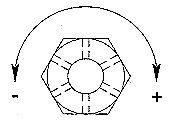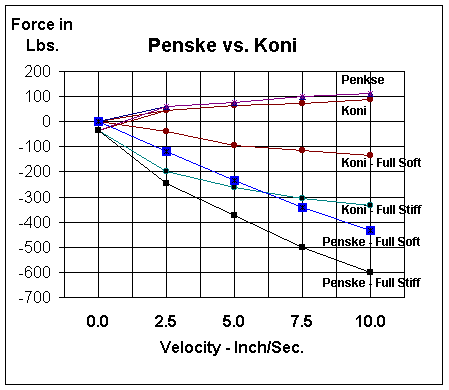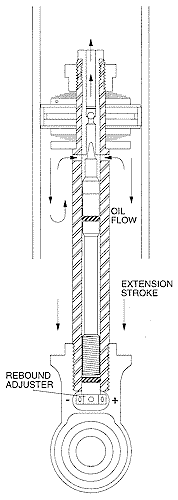Penske Shock Info |
| What follows is predominately information provided by Penske with the shocks. At the end I’ve included some info which is not generally available - and I think will be of interest. |
 The rebound
adjuster on the Spec Racer Ford shock absorber is located in the eyelet at the base of the
main shaft. Inside the window is an adjustment screw which serves as the control
point for rebound adjustments. The rebound
adjuster on the Spec Racer Ford shock absorber is located in the eyelet at the base of the
main shaft. Inside the window is an adjustment screw which serves as the control
point for rebound adjustments. |
The rebound adjuster has three full turns of adjustment or (18) flats. From the full hard setting, count out (18) flats to the full soft setting. The majority of adjustment is in the first (12) flats of adjustment from the full hard position. From the full hard setting, there are (3) full turns of adjustment (18 flats) out to the full soft setting. |
STARTING
SET-UP -- Per Penske |
| Shock Dyno Info -- Penske vs. Koni |
| The table below compares the
Penskes vs. the Koni’s at the extremes of their adjustment. This should provide
hours of enjoyment. Two other notes: First, there are more than 18 physical flats of
adjustment (my shocks have 20 to 21). After 18 flats softer than full stiff, nothing
changes. Second, the adjustments are fairly linear in their effect -- except in the region near full stiff...where the first 3 flats have significant effect. |
 |
| Rev. 9/12/98 |
| Feedback |
| I welcome your comments or ideas on this information. Feel free to drop me
a line via “Comments for the Bro’s”. Barry |
 During the rebound (extension) stage of the shock
movement, fluid is forced through two ports in the main shaft. Inside the main shaft is a
needle and jet assembly which adjusts the amount of fluid passing through the jet. By
turning in the rebound adjuster (clockwise), the needle is forced up into the jet,
restricting the fluid, causing firmer rebound damping forces. In reverse, by turning the
adjuster out (counter clock-wise), more oil is allowed to pass through the jet causing
lighter rebound damping forces. This rebound adjustment assembly, is in fact a timed
control for the rebound shims located on the main piston to work. The flow is checked in
the compression direction via a ball and seat valve.
During the rebound (extension) stage of the shock
movement, fluid is forced through two ports in the main shaft. Inside the main shaft is a
needle and jet assembly which adjusts the amount of fluid passing through the jet. By
turning in the rebound adjuster (clockwise), the needle is forced up into the jet,
restricting the fluid, causing firmer rebound damping forces. In reverse, by turning the
adjuster out (counter clock-wise), more oil is allowed to pass through the jet causing
lighter rebound damping forces. This rebound adjustment assembly, is in fact a timed
control for the rebound shims located on the main piston to work. The flow is checked in
the compression direction via a ball and seat valve.